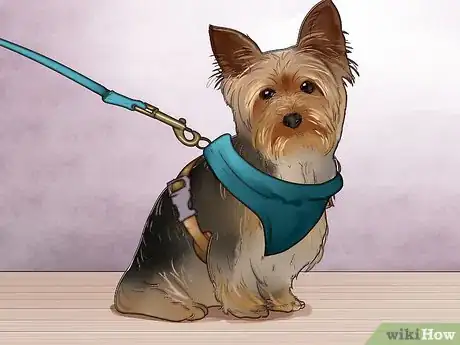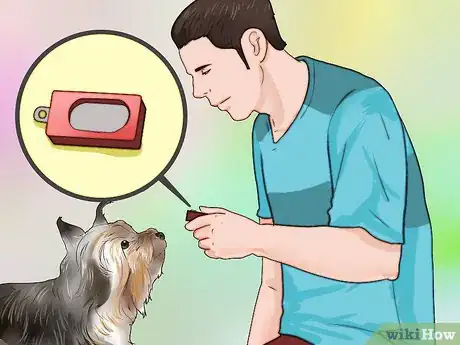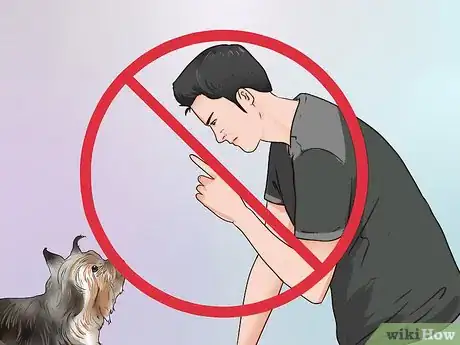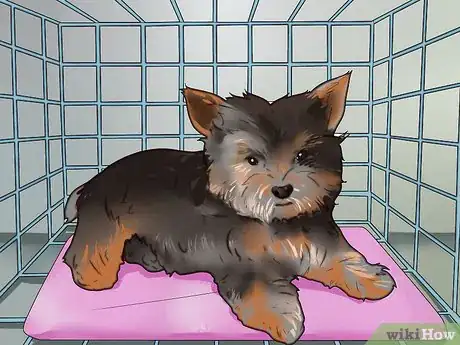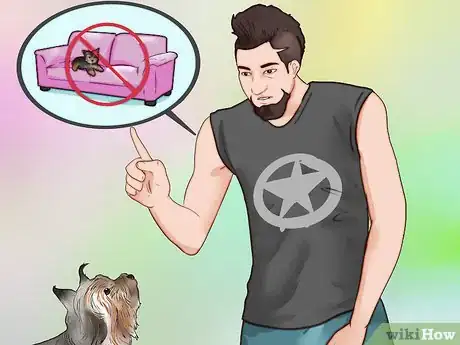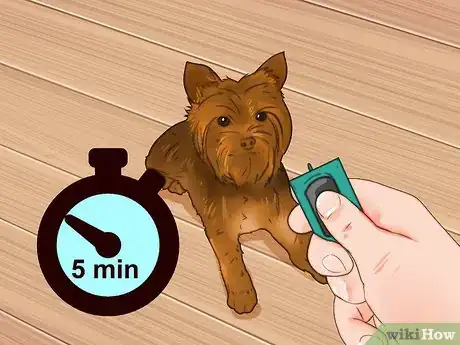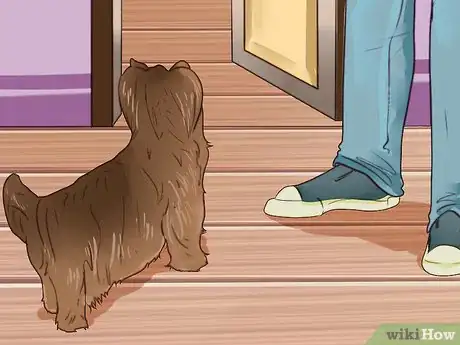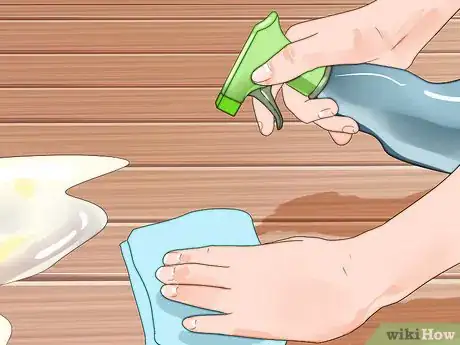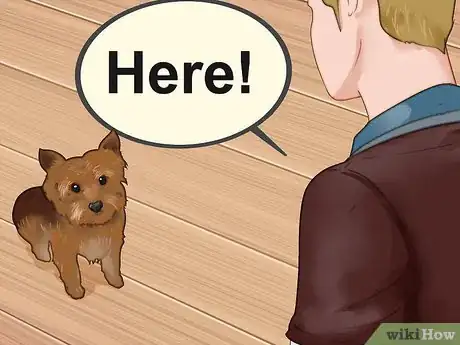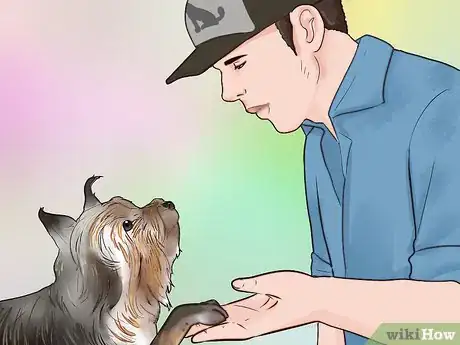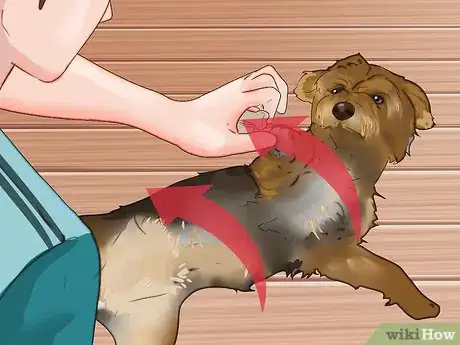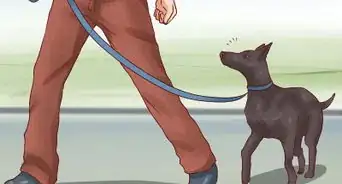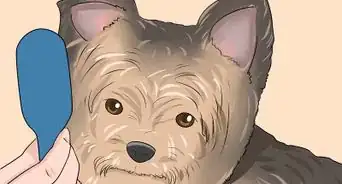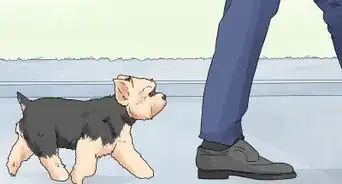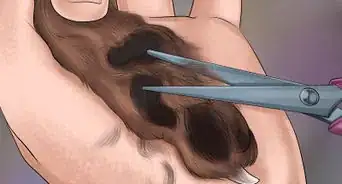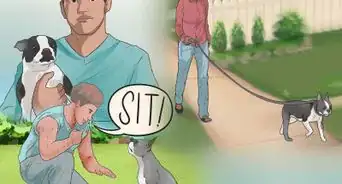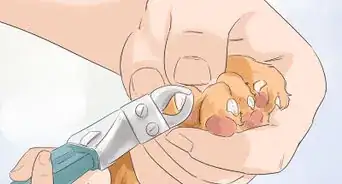This article was co-authored by Pippa Elliott, MRCVS. Dr. Elliott, BVMS, MRCVS is a veterinarian with over 30 years of experience in veterinary surgery and companion animal practice. She graduated from the University of Glasgow in 1987 with a degree in veterinary medicine and surgery. She has worked at the same animal clinic in her hometown for over 20 years.
There are 7 references cited in this article, which can be found at the bottom of the page.
wikiHow marks an article as reader-approved once it receives enough positive feedback. In this case, 85% of readers who voted found the article helpful, earning it our reader-approved status.
This article has been viewed 295,421 times.
Big personality and eye-appealing cuteness make the tiny Yorkshire Terrier one of the most popular dog breeds in the world. Despite its size, the territorial and intelligent Yorkie is a first-rate watchdog. But, because of unique behavioral traits, Yorkshire Terriers must be trained in at least the basic obedience commands or they will become uncontrollable pets. Owners seeking to train a Yorkie will find an eager pupil that grasps most of the basic commands quickly.
Steps
Learning Basic Training Strategies
-
1Get to know the breed. Yorkshire terriers are physically small dogs, but they originated from working dogs. They can be strong willed and are often described as having the temperament of a big dog in a small dog’s body.[1] Yorkshire terriers range widely in their intelligence. Some are quick learners while others are slow.
- You will soon find out if you have a quick learner by how quickly your Yorkie picks up basic commands.
- If your Yorkie is a slow learner, don’t fret. They are very trainable dogs, but you need to be patient and expect to repeat the same exercises on numerous occasions.[2]
-
2Choose a lightweight harness. Because Yorkies are so small, you should always use a lightweight harness for the dog’s leash rather than attaching the leash to your dog’s collar. In order to keep identification tags on your dog, you should also use a lightweight collar, and you should be able to insert a finger or two between the collar and your dog’s neck to ensure that it’s not too tight.Advertisement
-
3Learn the benefits of positive reinforcement. Dogs respond well to reward-based training. The principle behind this is that a good behavior—obeying a command, for instance—is immediately rewarded (usually with praise and a treat), which makes the dog associate the behavior with the reward. The dog will in turn want to repeat the behavior in order to continue receiving the reward.[3]
- When using treats to reward behavior, be careful not to overfeed. Cut back a little on the amount you give during regular meals so that the extra calories from the treats do not make your dog overweight. You can also cut back on treats (while still offering lots of praise) as your dog masters a behavior or command. Reduce to providing a treat every fourth or fifth time your Yorkie obeys instead of each time. This won’t weaken the training as long as you still praise the obedience.
-
4Consider using clicker training. A useful way to reward good behavior is clicker training. This involves using a small device that makes a clicking noise to mark the exact moment of the desired behavior. By training your dog to associate the click with praise and a treat, you can then mark moments of good behavior with the clicker and provide the reward. The click noise makes it even easier for your Yorkie to understand the exact moment of the good behavior.[4]
- For more information on the specifics of clicker training, check out How to Clicker Train Your Dog.
-
5Do not try to punish your Yorkie. While it seems intuitive to humans to punish bad behavior, negative attention is an ineffective deterrent for dogs. Giving your dog attention in the form of a scolding is actually rewarding the dog with attention in its eyes. If you simply ignore bad behavior, your dog is more likely to bore of it and stop repeating the behavior.[5]
-
6Distract your Yorkie from self-rewarding bad behaviors. While ignoring bad behavior is the most effective method for most behaviors, this won’t stop your Yorkie from exhibiting behaviors that the dog finds rewarding in themselves—such as chewing on your favorite pair of shoes. In these situations, you should try to distract the dog without calling attention to the bad behavior.[6]
- For example, you might "accidentally" kick your dog’s favorite chew toy and say “Oops" to draw attention to it. When your dog gets up and goes to the toy, pick up both your dog and the toy and set them in a different room away from the inappropriate object.[7]
- Whenever possible, you should also Yorkie-proof areas of your home to which your dog has access, which can take more planning than you’ll initially realize. For a dog that can’t reach very high, Yorkies still manage to get into trouble. Keep dangling cords, houseplants, clothes, and food out of reach, and don’t forget the effectiveness of baby gates for such a small dog.[8]
-
7Consider using crate training. Like other dog breeds, Yorkies are den animals and take to comfortable crates as safe places.[9] Proper crate training is especially helpful when house training your Yorkie since dogs will naturally try to hold their bladders in order not to go in their dens.[10]
- Never force your Yorkie into the crate or use it as a timeout spot, though. Crate training only works when the crate is a trusted, enjoyable space for your dog.
- For more information on the specific steps involved in crate training your Yorkie, read How to Crate Train Your Dog or Puppy.
-
8Remain consistent with all training. Set clear boundaries about what the dog is allowed to do and what is forbidden and be consistent above all. If you don’t allow your Yorkie to do something—jump up onto the sofa, for instance—then this must be the rule at all times. If you intermittently allow the dog up, it will only confuse your pup due to the mixed messages.[11]
-
9Use negative markers. You can let your Yorkie know that he or she is about to make a mistake by making a noise in a disapproving tone, such as "Uh uh.” This is called a "negative marker" and gives your dog valuable information that he or she is making a wrong choice. A negative marker is never backed up with punishment. It is not a warning but a clue as to how to behave, so the dog can change and make the right decision.[12]
- An example would be when teaching the “stay” command. If your dog stands from sit, a brief disapproving "uh uh" provides the information that standing is incorrect.
-
10Keep sessions brief when training Yorkies. Yorkies have a fairly short attention span. Train only a single command at any given time. The length of training sessions varies on the individual. As a guide, little and often is best. Try four- or five-minute sessions spread through the day.
- Do not forget that every interaction with your dog is also an opportunity for training. For example, before feeding, get your dog to sit and reward the behavior with the meal.
- Some commands are linked—such as “sit” and “stay”—but your dog should have a solid command of “sit” before you try linking “stay” to it.
Housebreaking Your Yorkie
-
1Show your dog the proper spot to go. As with other training, consistency is important when house training your Yorkie. Initially, pick a specific spot where you want your dog to toilet to help him or her associate the spot with going to the bathroom.[13]
-
2Take your Yorkie to the designated spot often. The first several instances of your dog toileting in the correct spot will be a matter of the right place at the right time. You can help your dog start to understand that it’s the correct behavior by offering plenty of praise and a treat for the happy coincidence.[14]
- For a puppy, this is as often as every twenty minutes when the dog hasn’t gone recently, as well as first thing in the morning, last thing at night, and after every meal.
- For an adult dog, this can be hourly, after sleep, and after meals.
-
3Do not punish your dog for accidents. As with other training, punishment is not an effective deterrent for your Yorkie when it comes to house training. Punishment will only make your dog wary of you and try to find more secretive places in the house to go.
- This includes rubbing your dog’s nose in the mess. This is not an effective deterrent. Your Yorkie won’t understand why you’re doing it.
-
4Clean any indoor messes thoroughly. Your dog will smell the remnants of any indoor messes and be drawn back to those spots to go again. Clean up any messes using an enzymatic cleaner to get rid of any lingering smell that could draw the dog back. This will help make the house-training process easier on both of you.
-
5Utilize your dog’s crate. If you’re crate training your Yorkie, ensure that you properly use it to help with toilet training. A crate can help because your Yorkie will be more reluctant to soil his or her "den" and more likely to hold on and go in the yard.[15]
-
6Watch for indications from your dog. As your Yorkie starts to understand that going in the correct place means a reward, he or she will want to obey. However, it’s not exactly easy for your pup to communicate to you that it’s time to go except by going. You have to offer your dog help in this arena by watching for telltale pacing, waiting by the door you use to take the dog out, whining, etc.
- If you’re running into difficulty with a stubborn pup, you can find more information on the entire house-training process at How to House Train a Puppy.
Teaching Your Yorkie Basic Commands
-
1Minimize distractions initially. Start training in a place with few distractions, such as a room at home or in your yard. As your dog starts to understand and respond to commands, be sure to vary the training spot. You don’t want your Yorkie to mistakenly believe that "sit" means “sit in front of the apple tree” or to accidentally tie other commands to a specific location.
- Slowly introduce the commands in busier areas as your dog begins to understand them. The ultimate goal is to ensure that your Yorkie will still obey the commands even with bustling people and other dogs around. Have patience since the amount of time this takes depends entirely on your specific dog’s personality.
- You’ll likely want to have your dog on leash as you slowly start to introduce more distractions since the chances of losing focus will be high at first.
-
2Teach your Yorkie the “here” command. Until your dog starts to get the hang of the “here” command, you’ll have to help him or her out by using it when the dog is already moving toward you. Use your clicker to mark the action (if clicker training) then give the reward.[16] After you’ve created a strong association between the two things, you can start to command "here" when your dog isn’t moving toward you.
- Do not continuously repeat the command if your dog doesn’t obey since it will weaken the command. Instead, resume waiting until the dog is already coming toward you to issue it. Wait until later to again try issuing the command when your dog is standing still or moving away.
- It can be a frustrating process. Remember to stay patient, not to punish, and always to reward your Yorkie when he or she does finally come to you.
-
3Teach your Yorkie to sit. Place the dog in the corner of a room and hold the treat at nose height. Let the dog sniff but not eat the treat. Raise the treat in an arc so that your dog’s nose goes up and bottom goes down. As his or her bottom hits the ground, click the clicker (if clicker training) and provide plenty of praise and a treat. Repeat the exercise often and start adding the “sit” command before raising the treat above your dog’s head.[17]
- Expect to repeat this process often before it fully registers with your Yorkie.
- As he or she starts to react to the command to sit, you can stop rewarding each individual instance and make the reward a bit less predictable, which will prevent overfeeding while still keeping your pup working toward the reward. Rewarding every fourth or fifth sit is ideal.
-
4Teach your Yorkie to shake. Have your dog sit and stay in that position. Gently pick up one of your dog’s front legs at the elbow and slide your hand down to around his or her wrist. Shake and then offer praise and treats. Remember to use the clicker if you’re clicker training. As your Yorkie begins to understand the trick, introduce a simple command like “shake” for the behavior. Repeat the action often until your dog understands the expected behavior[18]
-
5Teach your Yorkie to roll over. With your Yorkie in a prone position, take a treat and hold it next to the dog’s shoulder. As your pup turns his or her head toward the treat, continue bringing it back around the dog’s back toward the other shoulder. Your Yorkie will naturally follow the treat with his or her head, which will cause the pup to roll.[19] As with other tricks, make sure you click if using clicker training, and then provide plenty of praise and the treat. As your dog begins to understand the trick, introduce a simple command as you do it, such as “roll.”
- Initially, you may want to keep the hand not holding the treat on your Yorkie’s rump to keep the dog from standing up to follow the treat, or you can also teach your pup a “lay down” command before trying to teach the dog to roll over.
-
6Teach your Yorkie other commands. You can use the same training process for additional commands after your Yorkie masters these basic, important ones. Find ways to make happy coincidences of the behavior while marking it with your clicker (if clicker training) and providing plenty of praise and a treat. After many repetitions, you dog will begin to understand, and you can apply your desired command to the behavior.
- Remember to be patient above all else. Your Yorkie wants to learn and to please you, but it still takes time!
- You can find more information later to some other basic commands at How to Teach Your Dog Basic Commands.
Expert Q&A
Did you know you can get expert answers for this article?
Unlock expert answers by supporting wikiHow
-
QuestionHow do I stop my Yorkie from using the bathroom inside?
 Pippa Elliott, MRCVSDr. Elliott, BVMS, MRCVS is a veterinarian with over 30 years of experience in veterinary surgery and companion animal practice. She graduated from the University of Glasgow in 1987 with a degree in veterinary medicine and surgery. She has worked at the same animal clinic in her hometown for over 20 years.
Pippa Elliott, MRCVSDr. Elliott, BVMS, MRCVS is a veterinarian with over 30 years of experience in veterinary surgery and companion animal practice. She graduated from the University of Glasgow in 1987 with a degree in veterinary medicine and surgery. She has worked at the same animal clinic in her hometown for over 20 years.
Veterinarian Go back to basics, as if potty training a puppy. This means watching the dog indoors all the time, and putting him outside at the first sign of wanting to toilet. When you can't be there, keep the dog confined in a crate, and then take him outside straight away upon your return. Stay with the dog outside, and praise when they go toilet in the potty spot. Deodorize previous indoor accidents so they don't draw the dog back.
Go back to basics, as if potty training a puppy. This means watching the dog indoors all the time, and putting him outside at the first sign of wanting to toilet. When you can't be there, keep the dog confined in a crate, and then take him outside straight away upon your return. Stay with the dog outside, and praise when they go toilet in the potty spot. Deodorize previous indoor accidents so they don't draw the dog back. -
QuestionIs a 10-week-old puppy too young to train?
 Pippa Elliott, MRCVSDr. Elliott, BVMS, MRCVS is a veterinarian with over 30 years of experience in veterinary surgery and companion animal practice. She graduated from the University of Glasgow in 1987 with a degree in veterinary medicine and surgery. She has worked at the same animal clinic in her hometown for over 20 years.
Pippa Elliott, MRCVSDr. Elliott, BVMS, MRCVS is a veterinarian with over 30 years of experience in veterinary surgery and companion animal practice. She graduated from the University of Glasgow in 1987 with a degree in veterinary medicine and surgery. She has worked at the same animal clinic in her hometown for over 20 years.
Veterinarian Start potty training right away (8 weeks and above). At 10 weeks, you can start teaching puppies good things happen when they do what you ask (for example, they get a treat when you say "Sit"). A very young puppy like this has a short attention span and won't retain information for long, but it is a good age to start getting them accustomed to focusing on you.
Start potty training right away (8 weeks and above). At 10 weeks, you can start teaching puppies good things happen when they do what you ask (for example, they get a treat when you say "Sit"). A very young puppy like this has a short attention span and won't retain information for long, but it is a good age to start getting them accustomed to focusing on you. -
QuestionHow do you train a Yorkie not to bark?
 Pippa Elliott, MRCVSDr. Elliott, BVMS, MRCVS is a veterinarian with over 30 years of experience in veterinary surgery and companion animal practice. She graduated from the University of Glasgow in 1987 with a degree in veterinary medicine and surgery. She has worked at the same animal clinic in her hometown for over 20 years.
Pippa Elliott, MRCVSDr. Elliott, BVMS, MRCVS is a veterinarian with over 30 years of experience in veterinary surgery and companion animal practice. She graduated from the University of Glasgow in 1987 with a degree in veterinary medicine and surgery. She has worked at the same animal clinic in her hometown for over 20 years.
Veterinarian
Warnings
- Never hit a Yorkie or any dog for that matter.⧼thumbs_response⧽
Things You'll Need
- Dog treats
- Long leash
- Light-weight collar
- Small dog crate
- Dog training clicker (optional)
References
- ↑ http://www.vetstreet.com/dogs/yorkshire-terrier
- ↑ http://www.vetstreet.com/dogs/yorkshire-terrier
- ↑ Don't Shoot the Dog. Karen Pryor. Ringpress Books
- ↑ Don't Shoot the Dog. Karen Pryor. Ringpress Books
- ↑ Don't Shoot the Dog. Karen Pryor. Ringpress Books
- ↑ Don't Shoot the Dog. Karen Pryor. Ringpress Books
- ↑ Don't Shoot the Dog. Karen Pryor. Ringpress Books
- ↑ http://www.americanhumane.org/animals/adoption-pet-care/safety/pet-proofing-your-home.html
- ↑ Don't Shoot the Dog. Karen Pryor. Ringpress Books
- ↑ Don't Shoot the Dog. Karen Pryor. Ringpress Books
- ↑ Don’t Shoot the Dog. Karen Pryor. Ringpress Books
- ↑ The Power of Positive Dog Training. Pat Miller. Howell Book House
- ↑ Don't Shoot the Dog. Karen Pryor. Ringpress Books
- ↑ Don't Shoot the Dog. Karen Pryor. Ringpress Books
- ↑ Don't Shoot the Dog. Karen Pryor. Ringpress Books
- ↑ The Power of Positive Dog Training. Pat Miller. Howell Book House
- ↑ The Power of Positive Dog Training. Pat Miller. Howell Book House
- ↑ http://www.petplace.com/article/dogs/behavior-training/training-your-dog/teaching-your-dog-to-shake
- ↑ http://www.vetstreet.com/train/teach-the-trick-how-to-roll-over#0_u0zh63a5
About This Article
To train a Yorkie effectively, use positive reinforcement in the form of praise and treats and try to avoid yelling at your dog, which can have a negative effect. Be clear and consistent with your commands, boundaries, and training techniques to avoid confusion. Breaking your Yorkie's training into a few five minute sessions throughout the day works best since this breed has a fairly short attention span! For tips on housebreaking your Yorkie, read on!

